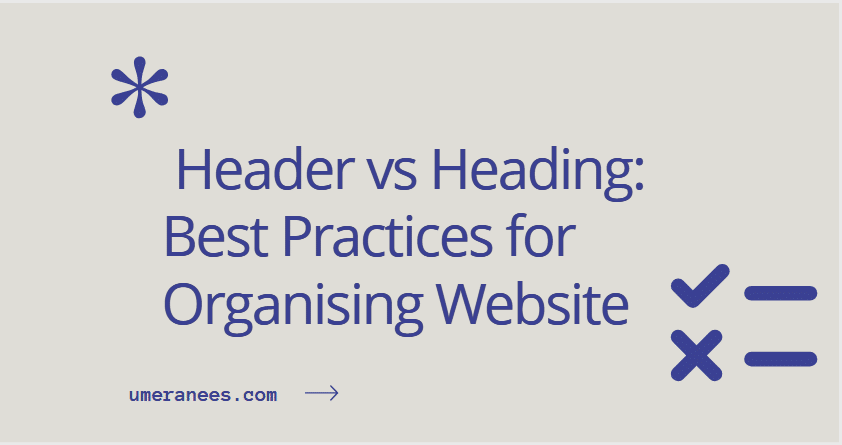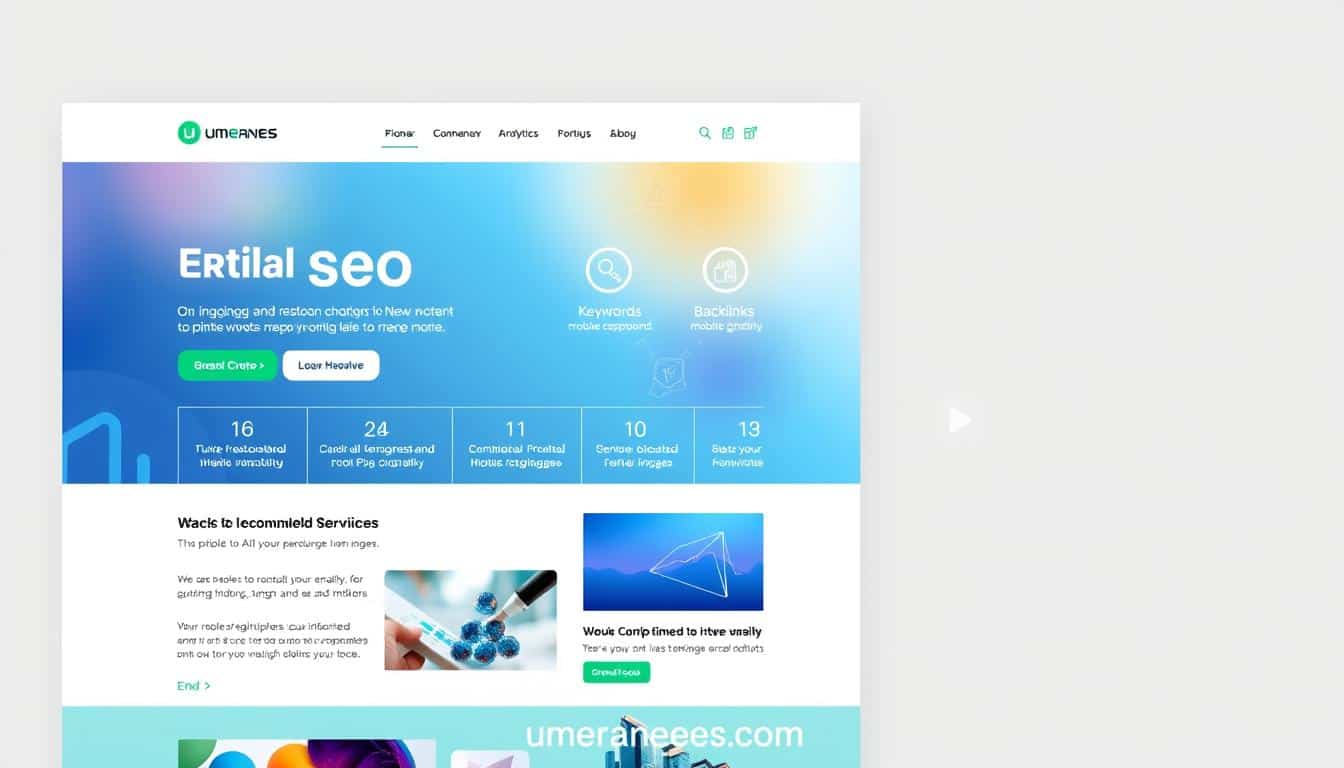Role of Header vs Heading
The structure of your pages, especially the header vs heading, is one of the most important factors to take into account when creating or optimizing a website. Despite their apparent similarity, these two phrases have diverse meanings in site design and affect user experience and SEO performance in various ways. We’ll go over the distinctions between headers and headings, their functions, and how to use them to your advantage to make a website that is both aesthetically pleasing and search engine friendly in this extensive article.
What is Header in the Page
Header is a part of any website that serves as a branding element and located at the top of the page. It contains a menu, website logo and sometimes a search bar or call to action button. Headers provide a good and user friendly experience to the visitors because it remains the same across all the pages of the website.

What are Headings and Subheadings in Content Writing
Headings and subheadings are the elements that help to organise the content within a web page. They help to separate the large block of text and make it easy for the readers to understand the information easily . They help search engines to understand the relevance of your information and also guide your users throughout the content. Headings like H1, h2 , h3 are used to define the structure of your content. So, h1 is the title of your post that is used one time only. Subheadings are the secondary headings that fall under the main headings. h2 vs h3 are the headings used further.
For the major part of your content, H2 tags are used, while H3 tags are utilized for subsections under H2. The perfect use of headings and subheadings not only improves readability but also enhances your On-Page SEO by signaling to search engines what your content is about.
What are Section Headers
The title or labels that represent different parts of a document or web page are section headers. They play a very important role in separating the information into sections and making it easy for readers.
Types of section headers:
Primary section headers
It represent the primary Division of content as
H1 is used as main title of the topic
H2 is used for major subsections and is under the h1
Secondary section headers
Within a main part, these headings offer more detail
H3: Applied to parts that fall beneath an H2 heading.
H4: Content is further divided beneath an H3 header.
Tertiary Sections headers:
These can be represented by h5 and h6 tags and are considerably more specific. They are employed in thorough subsections:
H5: Used beneath an H4 header for in-depth sections.
H6: Applies to the finest level of content segmentation.

HTML and Headers: The Technical Side
It is very important to understand html code for the area between header and body for the people who are working with HTML . Because this code determines the structure of your website and makes sure that content is separated and easy to visualise. The header and body text of your webpage are clearly divided due to this code, which also sets the webpage’s layout and spacing. Maintaining an organised, efficient, and visually attractive website layout can be aided by proper coding in this area.
By supplying the appropriate styling and space to differentiate the HTML code for the body under header, this piece of the code serves as a bridge. Developers can improve the user experience by creating a seamless and coherent transition between the header and body by appropriately organizing this intermediary space. This method guarantees that the content is easily accessible and well-organized, in addition to improving aesthetics.
What is HTML for Header in WordPress
The people using wordpress may wonder what is the HTML for header in WordPress. WordPress has built-in features that make customising headers simple, but if you’re digging into the code, it’s essential to understand how to work with the header section. It permits more thorough personalization, including adding particular scripts or changing the style to better match your identity.
Typically, the header.php file located in your theme directory defines the header area of a WordPress website. The HTML and PHP code in this file is what renders your website’s header, which typically consists of things like the site logo, navigation menu, and other content unique to the header.

How to Separate Header From Body in HTML
For advanced users and Developers separating the header from the content in the HTML structure is a very common practice. If you know how to separate header from body in HTML then you are able to manage and update the website more efficiently.
This practice is very helpful when you are dealing with complex sites that require updates. Also when you are creating templates that can be reused across different pages.

Having Header and Footer in Another HTML File
Depending on the environment you’re working in, you can use a variety of techniques to include the header and footer in different HTML files and then use them across numerous pages (e.g., using PHP, JavaScript, or server-side includes).
Header vs Heading: Which Tools Would You Use to Make a Header
There are several tools available for creating headers, including text editors, HTML editors, and content management systems. If you are searching which tools would you use to make header 1 the answer is here. Although the techniques used to create a header and Header 1 (H1) are often the similar, the context may cause some subtle variations in how they are applied:
1. Text Editors and IDEs: You can use text editors and integrated development environments (IDEs) such as the following to code headers in HTML or CSS:
Visual Studio Code; A well-liked option due to its wealth of features and web development extensions
Sublime Text: renowned for its simplicity and quickness.
Atom: Provides capabilities that are customisable and an easy-to-use interface.
2. CSS Frameworks: With predefined styles, these frameworks can simplify header design:
Bootstrap: Offers components and classes to create headers that are responsive.
Foundation: Provides resources for creating adaptable and personalised header designs.
3. .Shopify add header and provides options for adding and customizing headers in themes.
How to Get Header on First Page Only
You may occasionally wish to show the header on only the first page of the document or a section. There are a number of ways to accomplish this, depending on the platform or tool you’re using. You can set headers in Word to only show up on the first page by using the header settings. Use CSS with page selectors in print styles to display a header just on the first page and not on any subsequent ones.

How to Keep the Header Still in WordPress
You must utilize CSS styling to make the header of a WordPress theme stay at the top of the page when users scroll in order to maintain it stationary. Typically, the position fixed CSS property is used to do this. Here’s how to accomplish it:
Modify the CSS of your theme:
Find Your CSS File: Usually located in the theme’s stylesheet (style.css), but you can also utilize the WordPress Customizer or a custom CSS plugin.
Put the Fixed Header Styles in Place: To fix your header at the top of the page, include the following CSS code:
Role of SEO in Paragraph Spacing
One aspect that often goes overlooked is SEO recommended paragraph spacing website body. Appropriate paragraph spacing increases user engagement, which boosts readability and has a positive effect on your site’s SEO performance.
Making sure there is enough space between paragraphs, for instance, might improve the readability and appeal of your text. This can therefore decrease bounce rates and lengthen consumers’ stays on your website, two things that search engines find favourable. There’s more to optimising your header for SEO than just adding keywords. It’s about making sure your header is neat, coded correctly, and devoid of extraneous elements. Better rankings may result from using web tags wisely inside the header, which can aid search engines in deciphering the content and architecture of your website.
Conclusion
When considering header vs heading, remember that while the header provides overall navigation, the heading breaks down the content into sections, guiding the reader through the material. Proper use of header vs heading ensures a well-organised and user-friendly website. You may greatly improve the user experience, your site’s SEO performance, and eventually increase traffic to your website by being an expert at creating headers and headings.
FAQs
Q1: What is the difference between a headline and a header?
A: An article’s headline serves as the primary title or text that draws the reader in and provides an overview of the material. In contrast, a header is the area at the top of a web page or document that may have a logo, navigation links, or other structural components in addition to the headline.
Q2: What is the difference between a header and a head?
A: A header is a structural component that appears at the top of a web page or document and usually holds metadata, titles, and navigation. A head can simply mean the top or leading portion of something. It can refer to the section in HTML documents, which contains meta-information.
Q3: What’s the difference between a header and a title?
A: A header is a heading that appears at the top of a webpage or document. An article, book, document, etc. can be specifically named or designated by its title. The title might stand alone or be a part of the header.
Q4:In WordPress, how can the header be made static?
A: To make a sticky header that shows while visitors scroll down the page, use custom CSS or a plugin.
Q5: What role does SEO play in headers?
A: You may increase your chances of ranking higher in search results by using SEO in your headers, which helps search engines understand the content and structure of your website.







